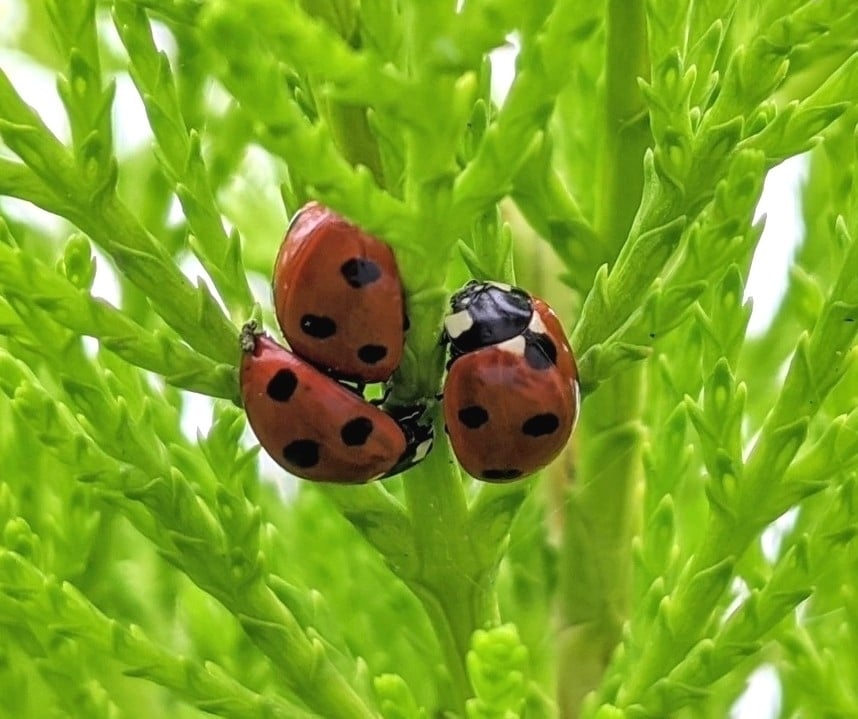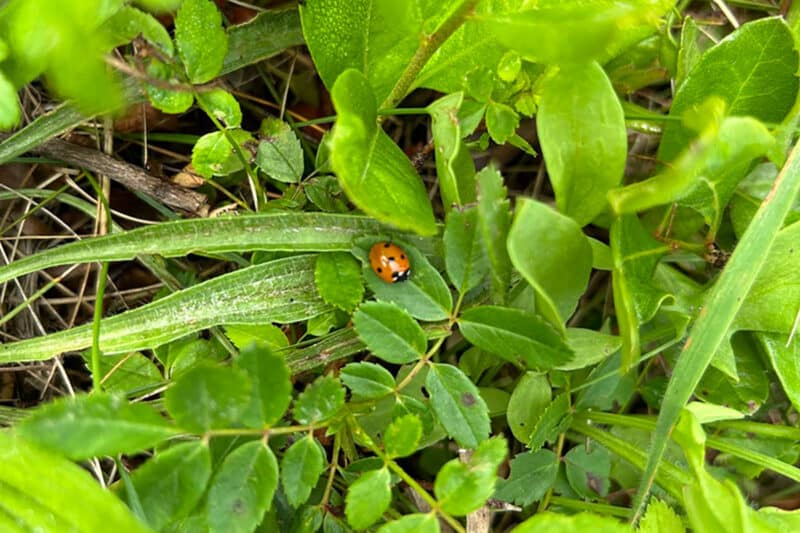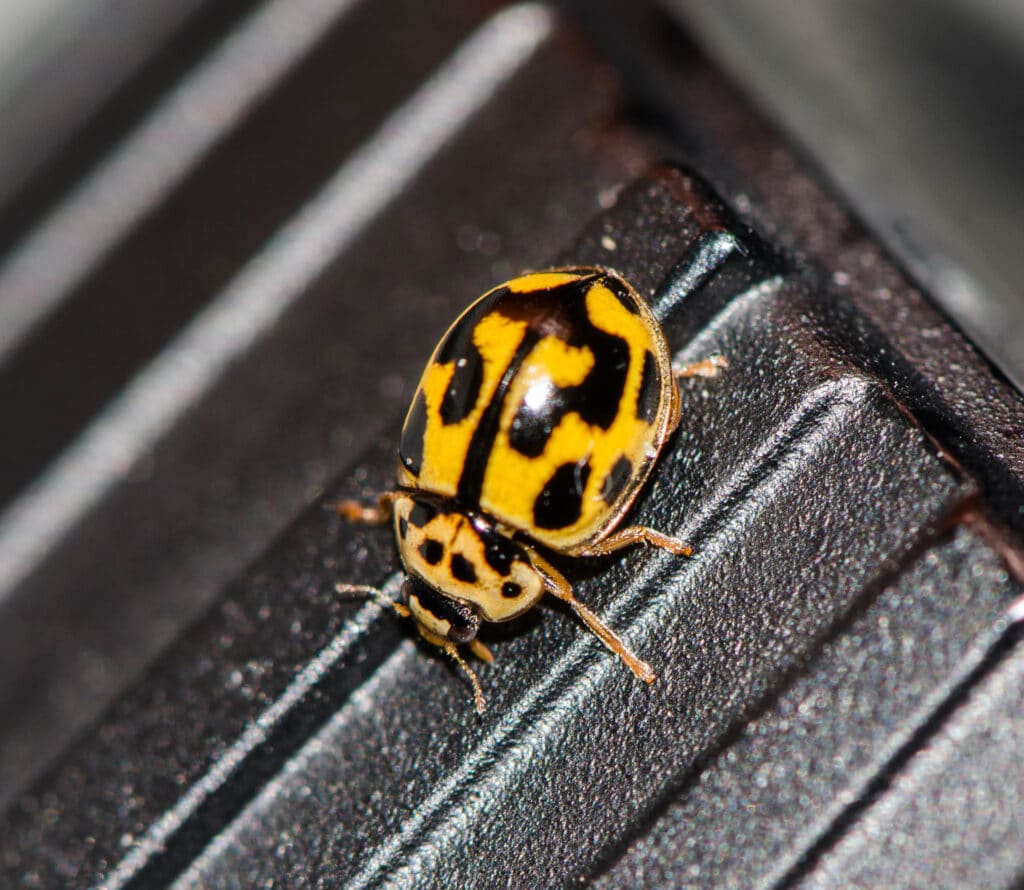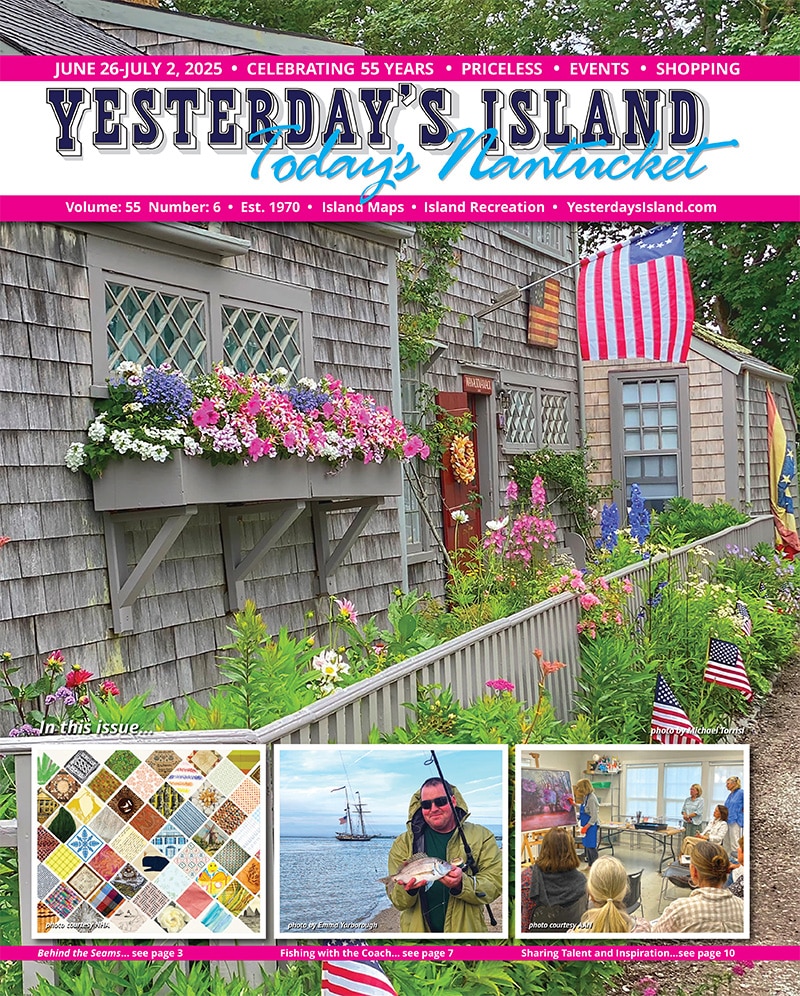by Dr. Sarah Treanor Bois, PhD
Director of Research & Education at the Linda Loring Nature Foundation
Ladybug season is upon us! As May rolls into June, we are at peak observation time for our myriad of ladybug species—when the larvae change into the adult stage we know and love. And even though it’s not unusual to see a ladybug around the island, it’s still a bit of summer magic to spot one.
There is a particular joy when seeing a ladybug, especially if you are lucky enough to have one land on you. It has always interested me how many people are afraid or wary of many insects, but delight in ladybugs. Maybe the take-away is to just add polka-dots to endear something to you. In many world cultures ladybugs are considered lucky, and killing one is said to bring sorrow and misfortune. If you make a wish while holding a ladybug, the direction that it flies away is said to be where your luck will come from.
Ladybugs aren’t just lucky. Since they eat aphids and other garden pests which can cause harm to some plants, gardeners delight in their presence and often encourage or even release them to biologically control the pests. Useful and lucky: what’s not to love about ladybugs?
What we generally call “ladybug” is actually a group of similar looking beetle species. Ladybug, ladybird, and lady beetle are all interchangeable words to mean coccinellid beetles (basically round-backed beetles). There is huge variety in this group with almost 5,000 known species worldwide. You may have noticed some differences in coloration and patterns when seeing various ladybugs. Take note: next time you see one and try to identify which species you have.
In New England, there are both native and non-native ladybug species. In general, the non-native ladybugs are similar in size to our native species, but their color and patterns are more variable, ranging from yellow to red and from no spots to up to a dozen spots or more.
Did you know that Massachusetts’ official state insect is the ladybug? In fact, 2024 marks the 50-year anniversary of the designation. The law was passed in 1974, after a large group of second graders from Kennedy School in Franklin, MA visited lawmakers at the State House in Boston. Apparently, they wore homemade ladybug costumes to inspire the bill, which was then signed into law. But what species of beetle is actually our state insect? It’s the Seven-Spotted Lady Beetle (Coccinella septempunctata): a non-native species that was established in the U.S. in the 1970s for pest control. As the name implies, the red beetle has 7 black spots and is, thus, easy to identify. These lady beetles have a broad ecological range, generally living wherever there are aphids to eat.

Coccinella septempunctata
The Seven-Spotted Lady Beetle is the most commonly introduced species in North America and commonly seen on Nantucket. The repeated introductions were done to reduce aphid numbers, using the ladybugs as a biological control agent. The first record of successful establishment (after numerous failed attempts to introduce the species) in the United States was in 1973. They have since spread by natural dispersion.
So, even though the Seven-Spotted Lady Beetle is not native and may be a pest to some people when they come inside, it is our state insect. It is also the state insect of Delaware, New Hampshire, Ohio, and Tenn essee. We do love our ladybugs!
Another common, non-native ladybug on Nantucket is the Asian Lady Beetle (Harmonia axyridis). This species is one of the most variable in terms of color shades, but all are many-spotted. They are typically seen in early to mid-June, so keep an eye out. Observations of this species pick up again in late fall when cold weather drives them inside. So many of these ladybugs are seen inside and outside homes during the fall, they earned the nickname “Halloween Beetle.” Our native species overwinter outside and wouldn’t be found in groups on your windowsill like the Asian Lady Beetles.
Like many ladybugs, the Asian Lady Beetle uses a chemical (isopropyl methoxy pyrazine) as a defense to deter predators. These insects will “reflex bleed” when agitated, releasing the chemical from their legs. The liquid has a foul odor (similar to that of dead leaves), a bitter taste, and can stain porous materials. This is why there can be stain on windowsills that have been covered by ladybugs. Even with that, they aren’t dangerous to you or your pets.
As a voracious predator, the Asian Lady Beetle was identified as a biocontrol agent for aphids and scale insects. Consequently, it has been introduced into greenhouses, crop fields, and gardens in many countries, including the United States. The first introductions into the U.S. took place as far back as 1916, but they didn’t become fully established until 1988.
Fourteen-Spotted Lady Beetle (Propylea quatuordecimpunctata) is another Nantucket species that isn’t native to North America. This one is a little easier to distinguish because of its yellow or chartreuse color with, you guessed it, 14 black spots. Native to parts of Europe, Asia, and Africa, they were originally introduced to the United States to help control the Russian wheat aphid. Their 14 spots are almost rectangular in shape and their color ranges from cream to light orange. These spots are rarely separate and they often blend together, creating larger patterns that can resemble an anchor.
The non-native ladybugs aren’t necessarily considered invasive. To be considered invasive, the insect must show some kind of harm: economic, human health, or ecological. There isn’t any evidence yet for ecological harm, since the introduced species occupy different habitats than the native species. There is no evidence for human harm. And, if anything, there has been a positive economical effect of introduced ladybugs due to reduction in insecticide use to combat aphids on agricultural lands. They may just be considered a pest to those whose windowsills they occupy come winter.
So what about our native ladybugs? The most common on Nantucket is the Two-Spotted Lady Beetle (Adalia bipunctata). The peak of seeing them (according to iNaturalist) is in early June, so now is a great time to look for them. As the name implies, the Two-Spotted Lady Beetle is a small red ladybug with a black dot on each side. There is also a less-common black morph that is shiny black with a few red spots.
Other native ladybug species with iNaturalist records on Nantucket include the Polished Lady Beetle (Cycloneda munda) which is red and has no spots, and Parenthesis Lady Beetle (Hippodamia parenthesis) which is red and looks like it had two black parentheses on either side. The Twice-Stabbed Lady Beetle (Chilocorus stigma) looks like a little black pith helmet with two red dots (hence the “twice stabbed”). It’s always helpful to have a name that makes sense! I couldn’t find any records on Nantucket for the Convergent Lady Beetle (Hippodamia convergens) but they are on the Cape and broadly in Massachusetts, so not unlikely. They are also native and common throughout North America. And these aren’t the only ladybugs to be found, only the most likely. Keep an eye out for color and spot variation.
With so much ladybug diversity, it’s no wonder we have one (or two) common names that encompasses all; ladybug/ladybeetle. Either way, if you are interested in identifying and learning more, take a photo of your ladybug find and submit the observation to iNaturalist. Identification will be confirmed, and you’ll be contributing valuable data which helps us know more about the ladybug diversity on Nantucket.





